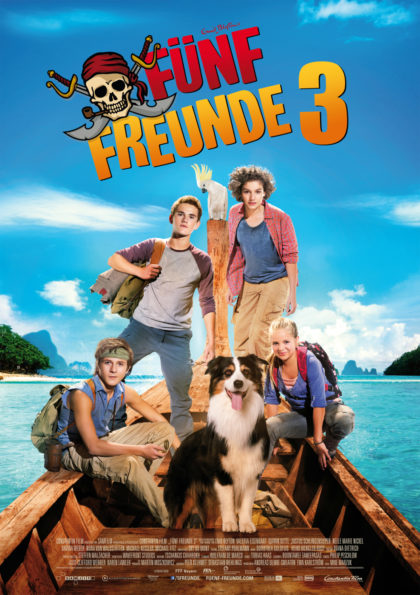
It is summer, and George and her dog Timmy travel to Thailand, following her father, who works on a project with an old friend concerning greenhouse gas. As usual, George brings her cousins Dick, Anne, and Julian with her so she does not have to spend the holidays alone. When the kids drive a motorboat into a secluded bay, they spot a shipwreck and decide to dive down there and explore it. Below deck, George finds a compass, and although they nearly get attacked by a shark, she manages to take the ancient object with her. When a young girl named Joe shows interest in the compass, the five friends realize they have discovered something valuable. With the help of Joe and her tribe, they reveal that an old pirate once capsized in front of Tao Lapai and buried his treasure somewhere on the island. When Julian gets bitten by a black oil beetle, only Timmy can save his life, rescue the kids, and help Joe’s tribe stay on the island.




Unlike the original title The Famous Five, the direct translation of the German title of the movie would be The Five Friends. Whether in the books, the audiobooks, or the movies, Timmy is an essential part of the group and the story. With his special abilities, the dog nearly always helps the kids find a treasure, saves them from dangerous situations, and surrounds the villain. The kids see the dog as a part of their group, and they take him with them wherever they go.
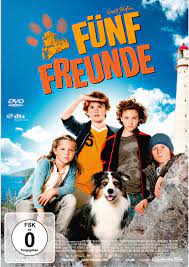
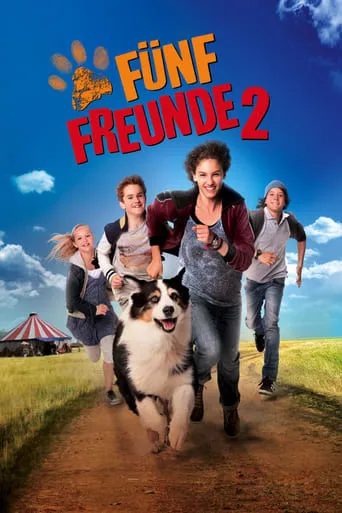
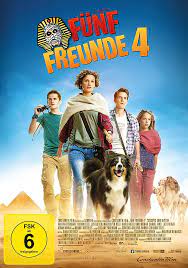
Timmy crosses the trunk and gets the berries for Julian
On the search for the berries that will save Julian’s life, Dick, George, and Joe have to stop in front of a gorge. They find a rotten trunk that can function as a bridge but is not steady enough to carry one of the kids. George immediately thinks of her four-legged friend and explains to Timmy what to do. The dog whimpers, keeps slipping off the trunk, and stops in the middle, creating the feeling that he is unsure whether to keep going forward or backward. Timmy makes it to the other side and celebrates his success with a couple of barks. He then runs to the berries, grabs a couple of twigs, and brings them back to the gorge.
The viewer’s first impression might be, that Timmy’s life does not have the same value, and for this reason, George sends him to the other side and not her cousin, but that is not the case. There are hundreds of situations in movies where friends are stuck, and the smallest has to crawl through a canal, fit through the window, or whatever escape there is. Timmy is not the smallest, but he is the lightest, for this reason, he is the one crossing the bridge. George says: “You are our only hope. Julian’s only hope”, and pets him before he crosses the bridge. Julian is also Timmy’s friend, and he wants to save his life just as much as the kids do.
The suspenseful music in the background, the pressing drums, and the ominous violins increase the tension of that moment. Shots from a bird’s eye depict how deep the gorge is and how far Timmy could fall. Shots from the side illustrate the bad state of the bridge and its high possibility of breaking. The shots from below enable the viewer to see the fear in the dog’s eyes and his posture. To emphasize Timmy’s anxiety, one can hear him whimper constantly and dog experts will recognize the lowered tail of the dog, which signals insecurity and concern.



Timmy takes the big jump over the gorge
After seeing Julian get weaker and weaker each moment, the viewer knows there is not much time left to save the boy. At this point in the movie, there is a juxtaposition of the kids in the cave and Timmy, who is stuck on the other side of the gorge after the villains destroyed the way back. One can see that Timmy is restless because he looks up and down, wags his tail, and he growls. Because there is one shot where the viewer can see basically through the dog’s eyes, it quickly becomes evident that Timmy wants to jump over the gorge. He picks up the berries and runs further away from the abyss to take a run-up. He then takes one last checking look at the gorge and runs. His posture and body language do not imply that Timmy is scared this time.
This scene is shot very dramatic. Timmy moves in slow motion, his fur is moving in waves as he runs toward the abyss. His ears and his tails wiggle. As soon as he starts moving, the music intensifies. At the same time, the rustling of the leaves on the ground and the two steps he takes before finally jumping are oddly loud. Looking at it in detail, one can realize that the scene was purposely lengthened. There are four different camera angles on Timmy, and he is at the edge of the abyss in every one of them. Firstly, he reaches the edge, running at the camera, then the focus lies on his paws and his body, filmed from the back, then again from a front angle, and lastly, another shot from the front with a wide range. When he takes the jump, the focus is on his paws.
The same applies to the flight over the abyss. First, the dog was filmed from above, then from the side, and finally from the front, with the camera positioned on the other side of the cliff. This sequencing is repeated similarly. We can see Timmy from below, flying over our heads, then from above, and finally, the camera films him from the front again. All these shots are full body shots and cut together in six seconds, each angle approximately one second long. What usually takes one second was stretched into six. This must have been a conscious choice that the producer made. It gives the audience more time to watch Timmy jump and reinforces the feeling that Timmy would not only once, but twice put his life in danger to rescue his friends. This time, George did not even have to ask for it.
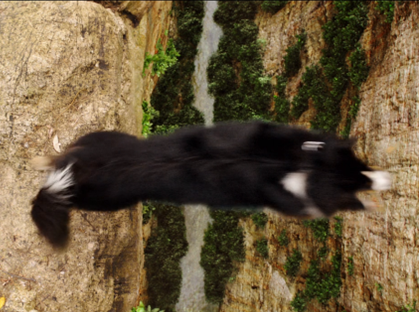
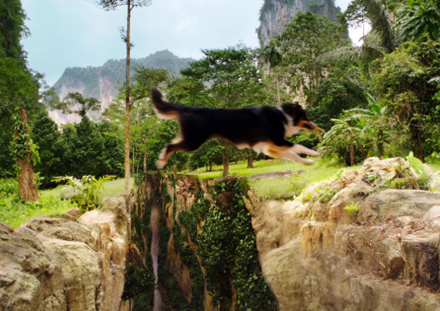
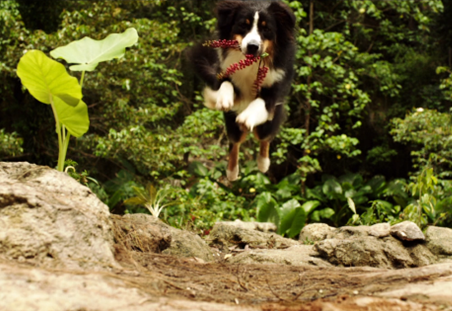
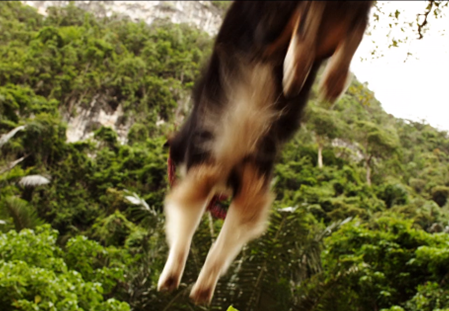
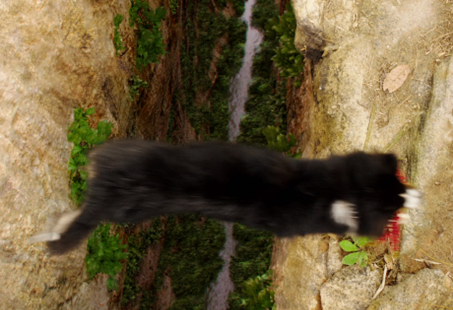
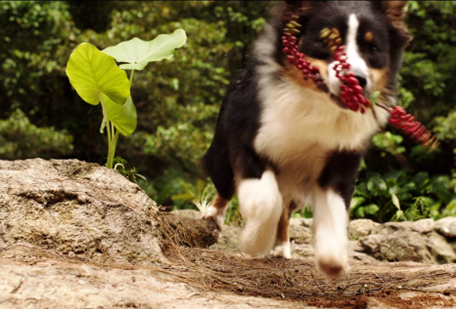
Figure 10: Sequence of shots
Timmy scares the evil hotel owner and stops the excavators
When the kids are surrounded, Timmy takes off. The female criminal laughs at George and sarcastically says: “Great friend!” because Timmy left them alone. In the following scene, we can witness that Timmy is not a coward but instead follows Mr. Haynes to the village. He appears in the back of his car, rushes through the village, and reappears on the other side of the excavator. As the hotel owner wants to climb onto the seat, Timmy jumps on it, which makes it possible for him to bark right in the face of the man. Because Timmy frightened him, Mr. Haynes staggered and fell to the ground. Timmy keeps barking at him and by doing so, keeps him away from the machine.
Usually, Timmy is not at all portrayed as scary. He is a domestic animal who obeys his owners. But sometimes Timmy makes his own decisions, like following Mr. Haynes instead of rescuing the children. He has a brain and a will of his own. In movies like these, it is easy to forget that dogs can be just as dangerous as other animals. This is the first time that Timmy seems remotely scary. He makes himself tall and barks loudly and angrily, and one can see the saliva dripping from his teeth. He sends the man threat and dominance signals, which indicates that he is preparing for a fight. In addition, the camera is positioned at an angle that lets Timmy appear even bigger and superior. Timmy could have easily bitten or at least caught Mr. Haynes with his teeth. But that is not what he did. Even though Timmy is in a superior position, he only warns the man not to come any closer, and signals, that he could attack if he wants to. Because this is a movie aimed at children, and because Timmy is a pet dog, he does not bite but only barks.
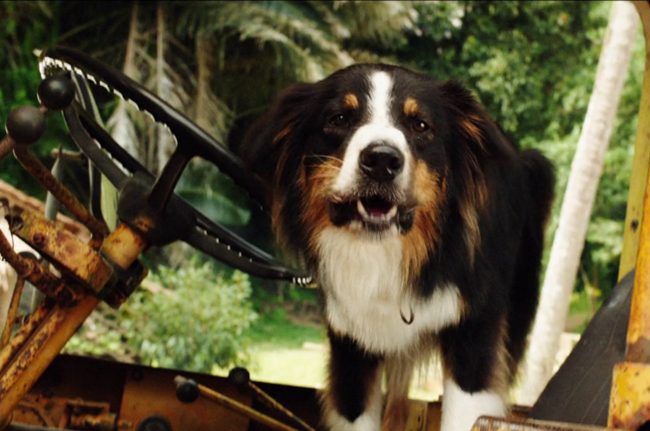
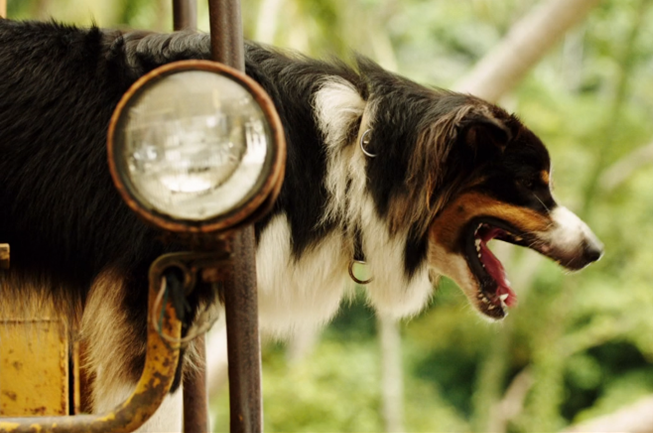
Timmy has special ways of communicating with the kids. Whenever the kids discuss something, and all agree on a decision, Timmy barks one loud time. That is a “Yes!” and the kids know that. He not only agrees with barking but also warns the kids and expresses fear or grief through barking or howling. Besides that, Timmy uses body language. He is immaculate at imitating the kids. He covers his face with his paw when he worries about the kids. He puts his paw over his nose when a chemical explodes, and instead of caressing Julian when he is sick, he licks his face. Licking is a sign of affection and simultaneously promotes endorphin release, which helps the dog calm down their stress or anxiety level.
Timmy is like their personal security system. Whenever someone approaches them in the dark, he lifts his head and listens even more attentively. He never fails to wake up George, who then can lead their friends to safety. Because of his sharpened senses that come with being a dog, Timmy always plays an important role in following a lead or racing after the villains. Therefore, every scene that includes Timmy is filmed with a wide angle, making sure that Timmy, who is on all fours, is visible.

This movie offers a conciliatory view of the relationship between animals and human beings, at least between dogs and humans. Timmy is treated like a human, he travels with the kids, sleeps in the same room, and is perceived as a valuable part of the group. He is not in a cage or on a leash, and he does not get punished for misbehaving. As a result of the trust Timmy and George have in each other, their relationship works without control and obedience. Even though he is unable to speak with the kids, they have their own ways of communicating. In some scenes the differences between dogs and humans are highlighted, but in a way that points out Timmy’s strengths and how the kids benefit from his speed, hearing, and sense of smell.

In comparison to other films like Jumanji, Timmy is not one of a hundred animals that can be substituted easily. He is an individual. Timmy is not just any dog, he is their best friend. Although domestic animals always belong to somebody and must obey their owner, Timmy has a relatively free life. The only constraints imposed upon him come from the outside world, like flying in a cage in the cargo compartment instead of with the kids on the airplane. He seems to understand the kids, feel emotions, and would risk his life for them. He is as much part of the group as the others. Without Timmy, The Five Friends would not exist.

Bibliography
https://www.disneyplus.com/de-de/movies/funf-freunde-3/5eNL4NSteUnd
Jumanji: Welcome to the Jungle. Dir. Jake Kasdan. Sony Pictures Releasing. 2017
Gibeault, S. (2023).’How to read dog body language’. American Kennel Club.
Lessa, E. (2023). ‘Why do dogs lick your face?’.petMD
https://constantin.film/home-entertainment/fuenf-freunde-3/
Further reading
Weir S., Kessler S.E. (2022) ‘The making of a (dog) movie star: The effect of the portrayal of dogs in movies on breed registrations in the United States’. PLoS One. 17(1).
Fayard, A. (2020) ‘How Dogs Representation in Cinema Reflects How They are Seen in the Real World’. Fall Student Research Symposium 2020. 19.